Fijian vs Dutch Community Comparison
COMPARE
Fijian
Dutch
Social Comparison
Social Comparison
Fijians
Dutch
3,167
SOCIAL INDEX
29.2/ 100
SOCIAL RATING
230th/ 347
SOCIAL RANK
6,444
SOCIAL INDEX
61.9/ 100
SOCIAL RATING
155th/ 347
SOCIAL RANK
Dutch Integration in Fijian Communities
The statistical analysis conducted on geographies consisting of 55,568,897 people shows a substantial positive correlation between the proportion of Dutch within Fijian communities in the United States with a correlation coefficient (R) of 0.549. On average, for every 1% (one percent) increase in Fijians within a typical geography, there is an increase of 0.162% in Dutch. To illustrate, in a geography comprising of 100,000 individuals, a rise of 1,000 Fijians corresponds to an increase of 162.0 Dutch.
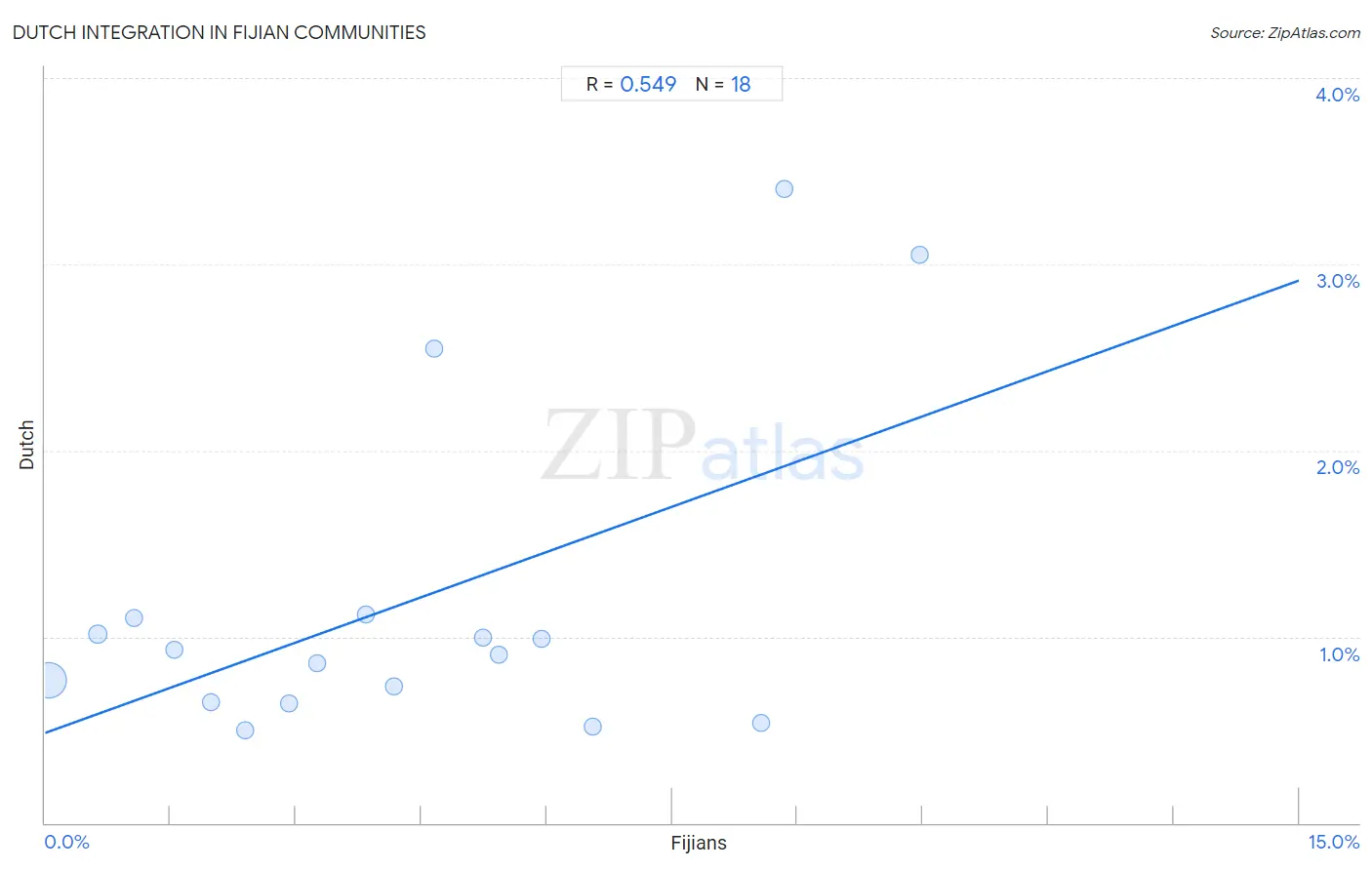
Fijian vs Dutch Income
When considering income, the most significant differences between Fijian and Dutch communities in the United States are seen in wage/income gap (22.9% compared to 29.6%, a difference of 29.4%), median male earnings ($45,607 compared to $54,410, a difference of 19.3%), and householder income ages 45 - 64 years ($85,187 compared to $99,650, a difference of 17.0%). Conversely, both communities are more comparable in terms of householder income under 25 years ($50,132 compared to $51,265, a difference of 2.3%), householder income over 65 years ($56,768 compared to $59,539, a difference of 4.9%), and median female earnings ($35,114 compared to $37,339, a difference of 6.3%).

| Income Metric | Fijian | Dutch |
| Per Capita Income | Tragic $36,690 | Fair $42,605 |
| Median Family Income | Tragic $87,387 | Fair $101,192 |
| Median Household Income | Tragic $74,205 | Fair $82,971 |
| Median Earnings | Tragic $40,193 | Poor $45,370 |
| Median Male Earnings | Tragic $45,607 | Average $54,410 |
| Median Female Earnings | Tragic $35,114 | Tragic $37,339 |
| Householder Age | Under 25 years | Tragic $50,132 | Tragic $51,265 |
| Householder Age | 25 - 44 years | Tragic $79,956 | Fair $93,081 |
| Householder Age | 45 - 64 years | Tragic $85,187 | Average $99,650 |
| Householder Age | Over 65 years | Tragic $56,768 | Poor $59,539 |
| Wage/Income Gap | Exceptional 22.9% | Tragic 29.6% |
Fijian vs Dutch Poverty
When considering poverty, the most significant differences between Fijian and Dutch communities in the United States are seen in married-couple family poverty (5.8% compared to 4.2%, a difference of 37.5%), receiving food stamps (13.0% compared to 10.0%, a difference of 30.1%), and family poverty (10.1% compared to 7.8%, a difference of 29.6%). Conversely, both communities are more comparable in terms of single male poverty (13.8% compared to 14.1%, a difference of 2.0%), female poverty among 18-24 year olds (20.0% compared to 20.5%, a difference of 2.5%), and single mother poverty (31.6% compared to 30.2%, a difference of 4.6%).
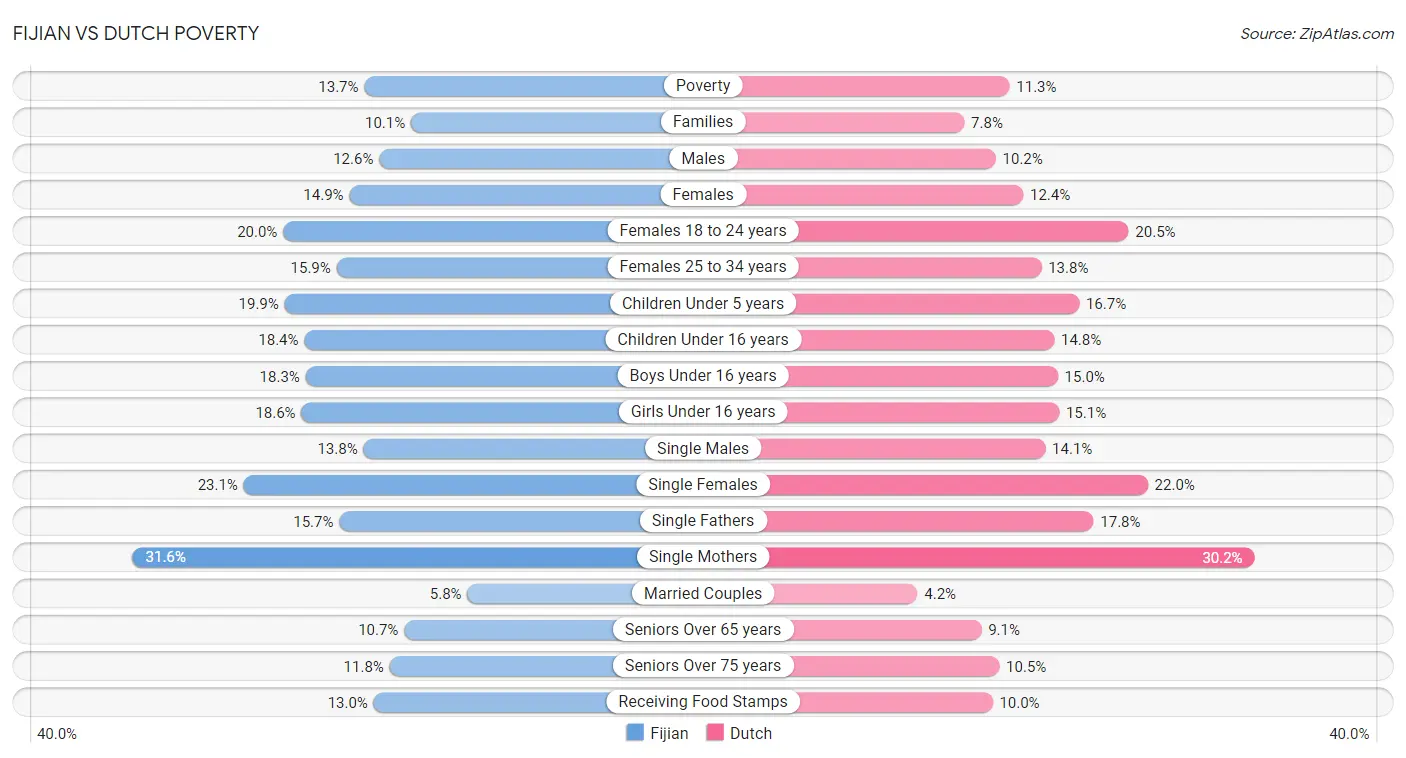
| Poverty Metric | Fijian | Dutch |
| Poverty | Tragic 13.7% | Exceptional 11.3% |
| Families | Tragic 10.1% | Exceptional 7.8% |
| Males | Tragic 12.6% | Exceptional 10.2% |
| Females | Tragic 14.9% | Exceptional 12.4% |
| Females 18 to 24 years | Average 20.0% | Poor 20.5% |
| Females 25 to 34 years | Tragic 15.9% | Fair 13.8% |
| Children Under 5 years | Tragic 19.9% | Good 16.7% |
| Children Under 16 years | Tragic 18.4% | Exceptional 14.8% |
| Boys Under 16 years | Tragic 18.3% | Exceptional 15.0% |
| Girls Under 16 years | Tragic 18.6% | Exceptional 15.1% |
| Single Males | Tragic 13.8% | Tragic 14.1% |
| Single Females | Tragic 23.1% | Tragic 22.0% |
| Single Fathers | Exceptional 15.7% | Tragic 17.8% |
| Single Mothers | Tragic 31.6% | Tragic 30.2% |
| Married Couples | Tragic 5.8% | Exceptional 4.2% |
| Seniors Over 65 years | Good 10.7% | Exceptional 9.1% |
| Seniors Over 75 years | Excellent 11.8% | Exceptional 10.5% |
| Receiving Food Stamps | Tragic 13.0% | Exceptional 10.0% |
Fijian vs Dutch Unemployment
When considering unemployment, the most significant differences between Fijian and Dutch communities in the United States are seen in unemployment among women with children ages 6 to 17 years (6.6% compared to 9.4%, a difference of 41.6%), unemployment among seniors over 75 years (8.7% compared to 10.4%, a difference of 19.7%), and unemployment among seniors over 65 years (4.2% compared to 5.1%, a difference of 19.3%). Conversely, both communities are more comparable in terms of female unemployment (4.7% compared to 4.6%, a difference of 2.1%), unemployment among ages 16 to 19 years (16.3% compared to 15.9%, a difference of 2.4%), and unemployment among women with children under 18 years (5.1% compared to 5.0%, a difference of 2.9%).
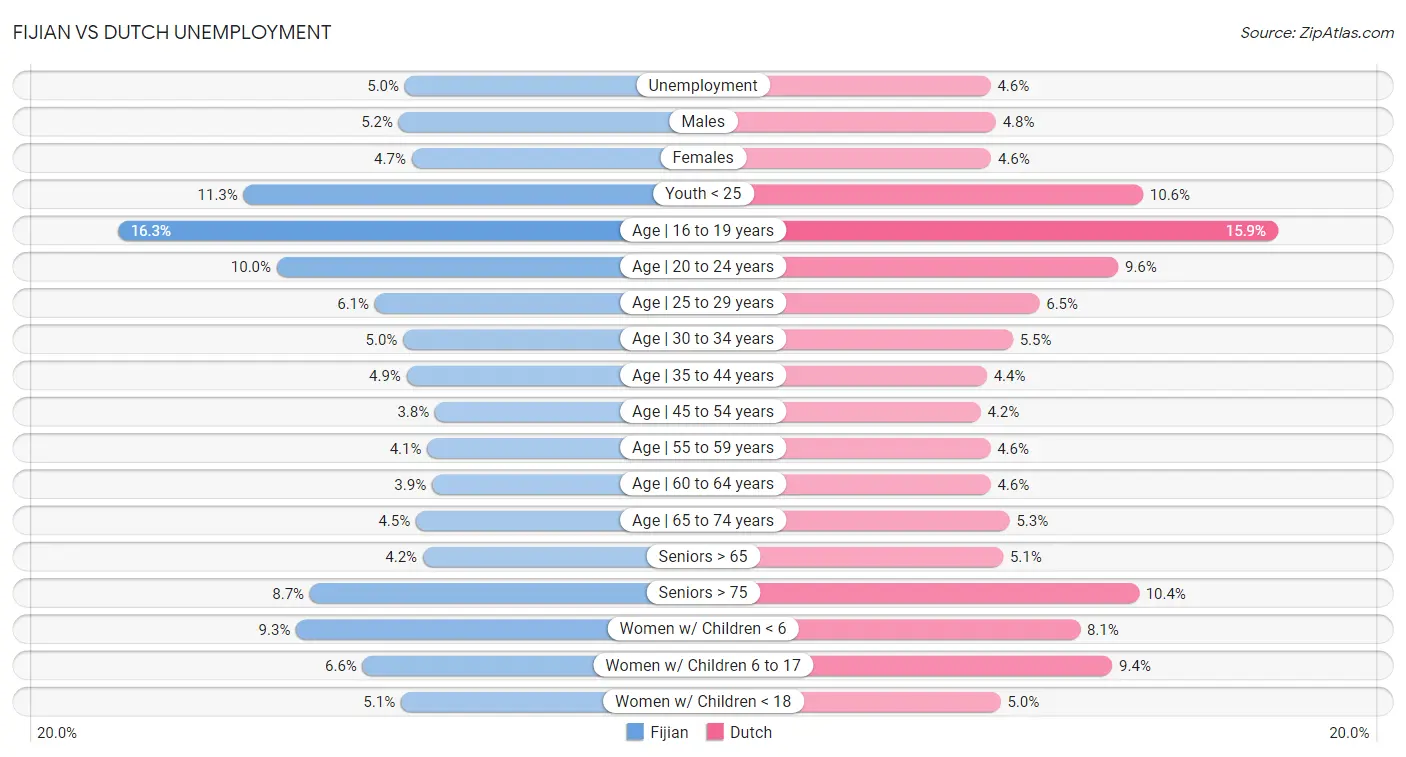
| Unemployment Metric | Fijian | Dutch |
| Unemployment | Exceptional 5.0% | Exceptional 4.6% |
| Males | Good 5.2% | Exceptional 4.8% |
| Females | Exceptional 4.7% | Exceptional 4.6% |
| Youth < 25 | Exceptional 11.3% | Exceptional 10.6% |
| Age | 16 to 19 years | Exceptional 16.3% | Exceptional 15.9% |
| Age | 20 to 24 years | Exceptional 10.0% | Exceptional 9.6% |
| Age | 25 to 29 years | Exceptional 6.1% | Excellent 6.5% |
| Age | 30 to 34 years | Exceptional 5.0% | Average 5.5% |
| Age | 35 to 44 years | Tragic 4.9% | Exceptional 4.4% |
| Age | 45 to 54 years | Exceptional 3.8% | Exceptional 4.2% |
| Age | 55 to 59 years | Exceptional 4.1% | Exceptional 4.6% |
| Age | 60 to 64 years | Exceptional 3.9% | Exceptional 4.6% |
| Age | 65 to 74 years | Exceptional 4.5% | Good 5.3% |
| Seniors > 65 | Exceptional 4.2% | Excellent 5.1% |
| Seniors > 75 | Average 8.7% | Tragic 10.4% |
| Women w/ Children < 6 | Tragic 9.3% | Tragic 8.1% |
| Women w/ Children 6 to 17 | Exceptional 6.6% | Tragic 9.4% |
| Women w/ Children < 18 | Exceptional 5.1% | Exceptional 5.0% |
Fijian vs Dutch Labor Participation
When considering labor participation, the most significant differences between Fijian and Dutch communities in the United States are seen in in labor force | age 16-19 (40.4% compared to 43.8%, a difference of 8.4%), in labor force | age 45-54 (80.2% compared to 82.8%, a difference of 3.2%), and in labor force | age 25-29 (82.9% compared to 84.9%, a difference of 2.4%). Conversely, both communities are more comparable in terms of in labor force | age > 16 (64.8% compared to 64.2%, a difference of 0.94%), in labor force | age 20-64 (78.4% compared to 79.3%, a difference of 1.2%), and in labor force | age 30-34 (83.4% compared to 84.5%, a difference of 1.3%).

| Labor Participation Metric | Fijian | Dutch |
| In Labor Force | Age > 16 | Poor 64.8% | Tragic 64.2% |
| In Labor Force | Age 20-64 | Tragic 78.4% | Fair 79.3% |
| In Labor Force | Age 16-19 | Exceptional 40.4% | Exceptional 43.8% |
| In Labor Force | Age 20-24 | Exceptional 77.4% | Exceptional 78.4% |
| In Labor Force | Age 25-29 | Tragic 82.9% | Excellent 84.9% |
| In Labor Force | Age 30-34 | Tragic 83.4% | Fair 84.5% |
| In Labor Force | Age 35-44 | Tragic 82.9% | Fair 84.3% |
| In Labor Force | Age 45-54 | Tragic 80.2% | Good 82.8% |
Fijian vs Dutch Family Structure
When considering family structure, the most significant differences between Fijian and Dutch communities in the United States are seen in single father households (3.0% compared to 2.4%, a difference of 24.4%), single mother households (7.2% compared to 5.8%, a difference of 24.1%), and average family size (3.36 compared to 3.11, a difference of 8.1%). Conversely, both communities are more comparable in terms of family households (65.9% compared to 64.9%, a difference of 1.5%), divorced or separated (12.6% compared to 12.4%, a difference of 1.7%), and births to unmarried women (32.3% compared to 31.5%, a difference of 2.4%).

| Family Structure Metric | Fijian | Dutch |
| Family Households | Exceptional 65.9% | Exceptional 64.9% |
| Family Households with Children | Exceptional 29.0% | Fair 27.4% |
| Married-couple Households | Fair 46.1% | Exceptional 49.5% |
| Average Family Size | Exceptional 3.36 | Tragic 3.11 |
| Single Father Households | Tragic 3.0% | Poor 2.4% |
| Single Mother Households | Tragic 7.2% | Exceptional 5.8% |
| Currently Married | Fair 46.3% | Exceptional 49.6% |
| Divorced or Separated | Tragic 12.6% | Tragic 12.4% |
| Births to Unmarried Women | Fair 32.3% | Average 31.5% |
Fijian vs Dutch Vehicle Availability
When considering vehicle availability, the most significant differences between Fijian and Dutch communities in the United States are seen in no vehicles in household (9.5% compared to 6.8%, a difference of 39.0%), 2 or more vehicles in household (57.6% compared to 61.6%, a difference of 7.0%), and 3 or more vehicles in household (22.2% compared to 22.9%, a difference of 3.1%). Conversely, both communities are more comparable in terms of 4 or more vehicles in household (7.8% compared to 7.7%, a difference of 2.1%), 1 or more vehicles in household (90.5% compared to 93.3%, a difference of 3.0%), and 3 or more vehicles in household (22.2% compared to 22.9%, a difference of 3.1%).

| Vehicle Availability Metric | Fijian | Dutch |
| No Vehicles Available | Exceptional 9.5% | Exceptional 6.8% |
| 1+ Vehicles Available | Exceptional 90.5% | Exceptional 93.3% |
| 2+ Vehicles Available | Exceptional 57.6% | Exceptional 61.6% |
| 3+ Vehicles Available | Exceptional 22.2% | Exceptional 22.9% |
| 4+ Vehicles Available | Exceptional 7.8% | Exceptional 7.7% |
Fijian vs Dutch Education Level
When considering education level, the most significant differences between Fijian and Dutch communities in the United States are seen in no schooling completed (2.5% compared to 1.4%, a difference of 74.1%), doctorate degree (1.1% compared to 1.8%, a difference of 57.1%), and professional degree (2.9% compared to 4.0%, a difference of 37.9%). Conversely, both communities are more comparable in terms of nursery school (97.6% compared to 98.7%, a difference of 1.1%), kindergarten (97.5% compared to 98.6%, a difference of 1.1%), and 1st grade (97.5% compared to 98.6%, a difference of 1.1%).
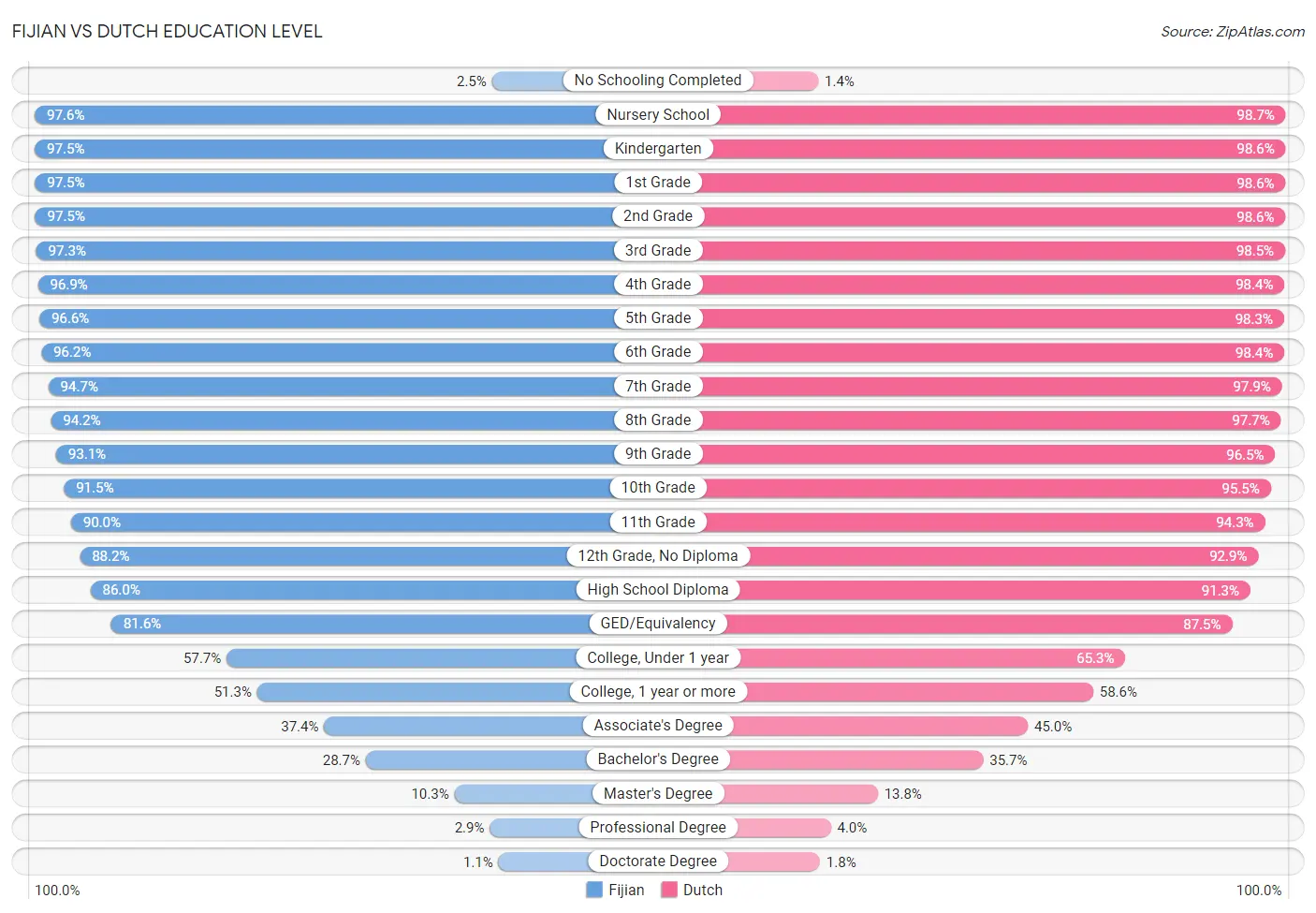
| Education Level Metric | Fijian | Dutch |
| No Schooling Completed | Tragic 2.5% | Exceptional 1.4% |
| Nursery School | Tragic 97.6% | Exceptional 98.7% |
| Kindergarten | Tragic 97.5% | Exceptional 98.6% |
| 1st Grade | Tragic 97.5% | Exceptional 98.6% |
| 2nd Grade | Tragic 97.5% | Exceptional 98.6% |
| 3rd Grade | Tragic 97.3% | Exceptional 98.5% |
| 4th Grade | Tragic 96.9% | Exceptional 98.4% |
| 5th Grade | Tragic 96.6% | Exceptional 98.3% |
| 6th Grade | Tragic 96.2% | Exceptional 98.4% |
| 7th Grade | Tragic 94.7% | Exceptional 97.9% |
| 8th Grade | Tragic 94.2% | Exceptional 97.7% |
| 9th Grade | Tragic 93.1% | Exceptional 96.5% |
| 10th Grade | Tragic 91.5% | Exceptional 95.5% |
| 11th Grade | Tragic 90.0% | Exceptional 94.3% |
| 12th Grade, No Diploma | Tragic 88.2% | Exceptional 92.9% |
| High School Diploma | Tragic 86.0% | Exceptional 91.3% |
| GED/Equivalency | Tragic 81.6% | Exceptional 87.5% |
| College, Under 1 year | Tragic 57.7% | Average 65.3% |
| College, 1 year or more | Tragic 51.3% | Fair 58.6% |
| Associate's Degree | Tragic 37.4% | Poor 45.0% |
| Bachelor's Degree | Tragic 28.7% | Tragic 35.7% |
| Master's Degree | Tragic 10.3% | Tragic 13.8% |
| Professional Degree | Tragic 2.9% | Tragic 4.0% |
| Doctorate Degree | Tragic 1.1% | Fair 1.8% |
Fijian vs Dutch Disability
When considering disability, the most significant differences between Fijian and Dutch communities in the United States are seen in disability age under 5 (1.2% compared to 1.7%, a difference of 41.0%), disability age 65 to 74 (27.0% compared to 23.3%, a difference of 15.6%), and self-care disability (2.7% compared to 2.4%, a difference of 11.0%). Conversely, both communities are more comparable in terms of disability (12.8% compared to 12.8%, a difference of 0.26%), male disability (12.6% compared to 12.7%, a difference of 1.1%), and female disability (13.1% compared to 12.9%, a difference of 1.4%).
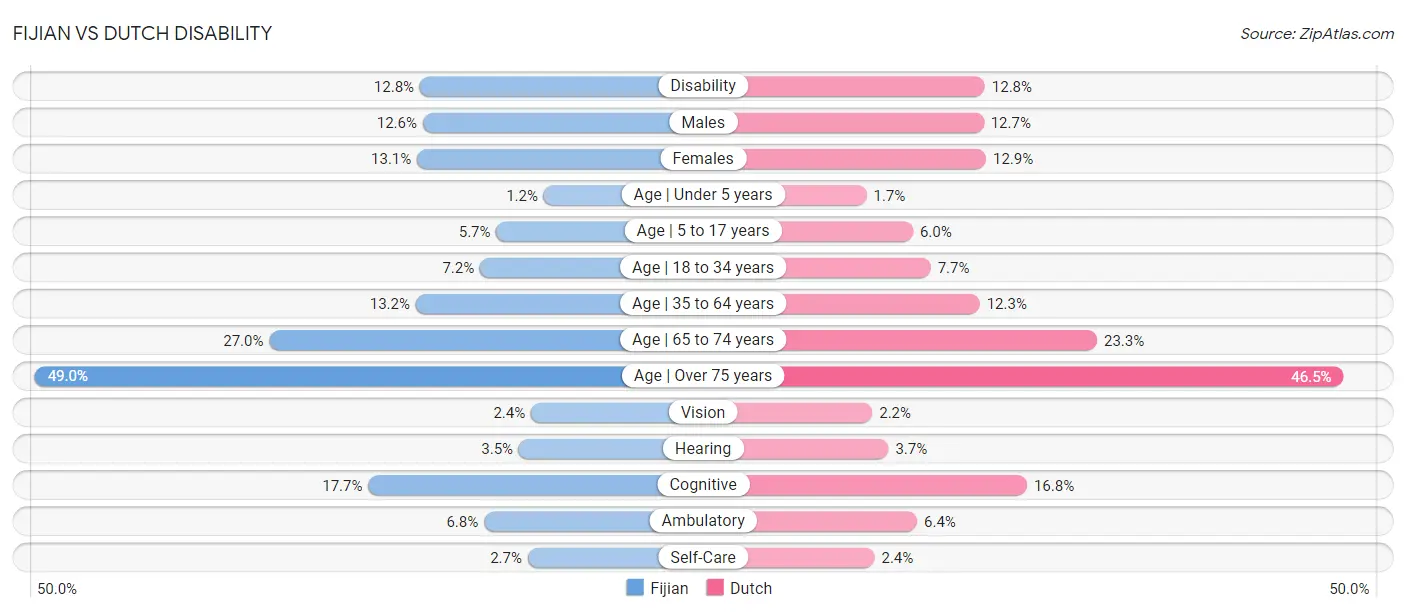
| Disability Metric | Fijian | Dutch |
| Disability | Tragic 12.8% | Tragic 12.8% |
| Males | Tragic 12.6% | Tragic 12.7% |
| Females | Tragic 13.1% | Tragic 12.9% |
| Age | Under 5 years | Excellent 1.2% | Tragic 1.7% |
| Age | 5 to 17 years | Fair 5.7% | Tragic 6.0% |
| Age | 18 to 34 years | Tragic 7.2% | Tragic 7.7% |
| Age | 35 to 64 years | Tragic 13.2% | Tragic 12.3% |
| Age | 65 to 74 years | Tragic 27.0% | Average 23.3% |
| Age | Over 75 years | Tragic 49.0% | Exceptional 46.5% |
| Vision | Tragic 2.4% | Poor 2.2% |
| Hearing | Tragic 3.5% | Tragic 3.7% |
| Cognitive | Tragic 17.7% | Exceptional 16.8% |
| Ambulatory | Tragic 6.8% | Tragic 6.4% |
| Self-Care | Tragic 2.7% | Good 2.4% |